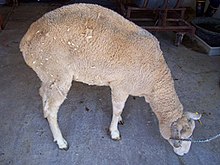
Back قعاص الغنم Arabic Scrapie Catalan Scrapie Czech Scrapie German Ŝaftremo Esperanto Tembladera Spanish اسکرپی Persian Skrapi Finnish Tremblante du mouton French Scráibeach Irish
This article contains close paraphrasing of non-free copyrighted sources. (May 2023) |


Scrapie (/ˈskreɪpi/) is a fatal, degenerative disease affecting the nervous systems of sheep and goats.[1] It is one of several transmissible spongiform encephalopathies (TSEs), and as such it is thought to be caused by a prion.[2][3] Scrapie has been known since at least 1732 and does not appear to be transmissible to humans.[4][5] However, it has been found to be experimentally transmissible to humanised transgenic mice[6] and non-human primates.[7]
The name scrapie is derived from one of the clinical signs of the condition, wherein affected animals will compulsively scrape off their fleeces against rocks, trees or fences. The disease apparently causes an itching sensation in the animals. Other clinical signs include excessive lip smacking, altered gaits and convulsive collapse.[8]
Scrapie is infectious and transmissible among conspecifics, so one of the most common ways to contain it (since it is incurable) is to quarantine and kill those affected. However, scrapie tends to persist in flocks and can also arise spontaneously in flocks that have not previously had cases of the disease. The mechanism of transmission between animals and other aspects of the biology of the disease are only poorly understood, and are active areas of research. Recent studies suggest prions may be spread through urine and persist in the environment for decades.[9]
Scrapie usually affects sheep around three to five years of age.[10] The potential for transmission at birth and from contact with placental tissues is apparent.[11]
- ^ Detwiler LA (1992). "Scrapie". Rev. Sci. Tech. Off. Int. Epiz. 11 (2): 491–537. doi:10.20506/rst.11.2.607. PMID 1617202.
- ^ Hunter N (2007). "Scrapie: uncertainties, biology and molecular approaches" (PDF). Biochim. Biophys. Acta. 1772 (6): 619–28. doi:10.1016/j.bbadis.2007.04.007. hdl:20.500.11820/70731351-7cc2-4746-908f-1dfaa331ad7f. PMID 17560089.
- ^ "Safety & Availability (Biologics) - Bovine Spongiform Encephalopathy (BSE) Questions and Answers". FDA. 2019-05-22.
- ^ National Scrapie Education Initiative. "Scrapie Fact Sheet". National Institute for Animal Agriculture. Archived from the original on 12 December 2020. Retrieved 4 December 2011.
- ^ Rolf G. "From Sheep to Humans: Scrapie and Creutzfeldt–Jakob Disease". Ecclectica. Archived from the original on 27 August 2011. Retrieved 4 December 2011.
- ^ Cassard H, Torres JM, Lacroux C, Douet JY, Benestad SL, Lantier F, Lugan S, Lantier I, Costes P, Aron N, Reine F, Herzog L, Espinosa JC, Beringue V, Andréoletti O (2014-12-16). "Evidence for zoonotic potential of ovine scrapie prions". Nature Communications. 5: 5821. Bibcode:2014NatCo...5.5821C. doi:10.1038/ncomms6821. hdl:20.500.12792/5784. ISSN 2041-1723. PMID 25510416. S2CID 205333618.
- ^ Comoy E, Mikol J, Luccantoni-Freire S (2015). "Transmission of scrapie prions to primate after an extended silent incubation period". Scientific Reports. 5: 11573. Bibcode:2015NatSR...511573C. doi:10.1038/srep11573. PMC 4485159. PMID 26123044.
- ^ Foster JD, Parnham D, Chong A, Goldmann W, Hunter N (2001). "Clinical signs, histopathology and genetics of experimental transmission of BSE and natural scrapie to sheep and goats". Vet. Rec. 148 (6): 165–71. doi:10.1136/vr.148.6.165. PMID 11258721. S2CID 43497666.
- ^ Detwiler LA, Baylis M (2003). "The epidemiology of scrapie" (PDF). Rev. Sci. Tech. Off. Int. Epiz. 22 (1): 121–43. doi:10.20506/rst.22.1.1386. PMID 12793776. Archived from the original (PDF) on 2015-05-08. Retrieved 2016-11-28.
- ^ Animal and Plant Health Inspection Service (June 2, 2020). "Scrapie Disease Information". U.S. DEPARTMENT OF AGRICULTURE.
- ^ Animal and Plant Health Inspection Service (June 2, 2020). "Scrapie". U.S. DEPARTMENT OF AGRICULTURE.
© MMXXIII Rich X Search. We shall prevail. All rights reserved. Rich X Search